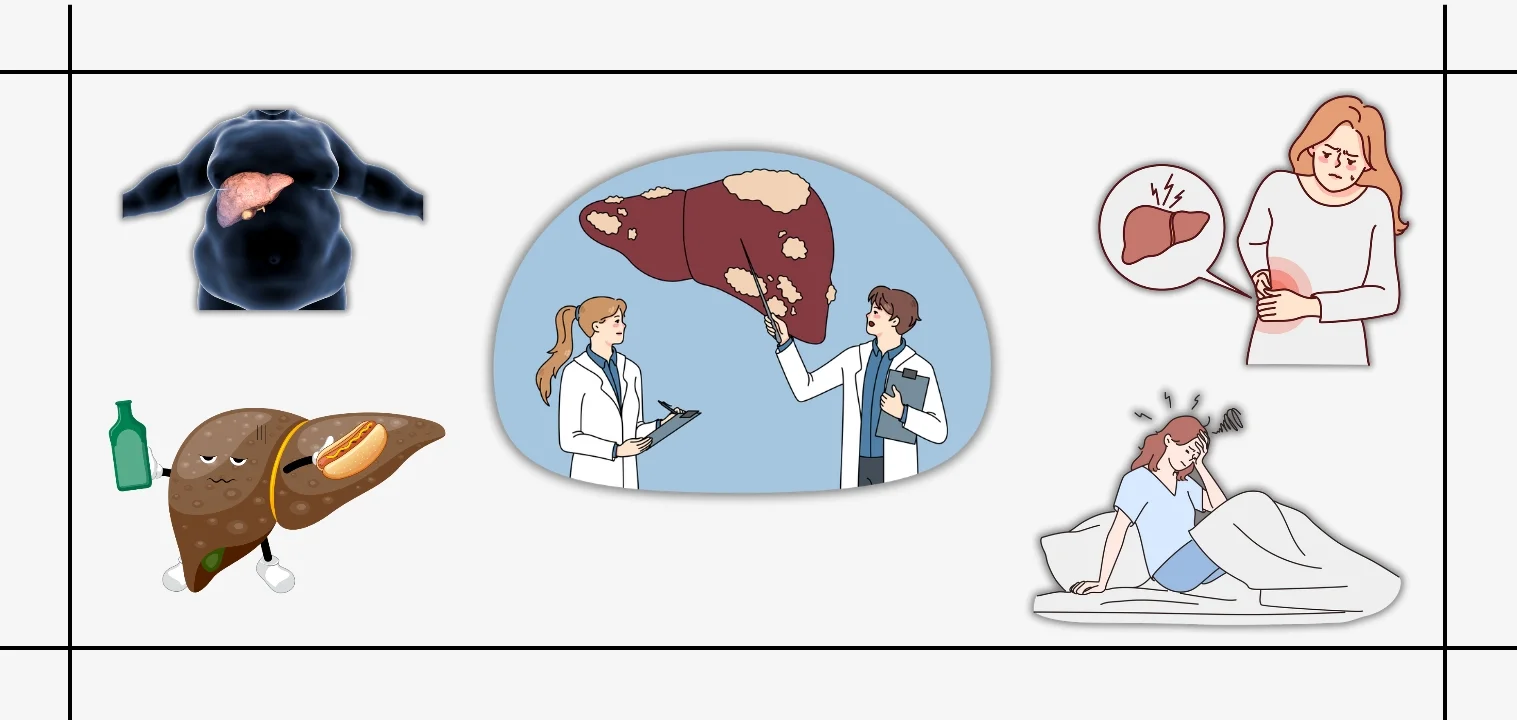-: FATTY LIVER :-
Fatty Liver, in this condition excess amount of fat accumulates in your liver. Fatty Liver also known as Hepatic Steatosis. Over time, this fat accumulation can impair your liver’s function. The condition becomes problematic when the fat makes up more than 5% of your liver’s weight. There are two primary types of fatty liver disease:-
1> Metabolic dysfunction-associated steatotic liver disease (MASLD, formerly non-alcoholic fatty liver disease, NAFLD) and
2> Alcohol-related fatty liver disease (ALD)
Symptoms
- Swollen belly.
- Enlarged blood vessels underneath your skin.
- Larger-than-normal breasts in men.
- Red palms.
- Pain or fullness in the upper right side of your tummy.
- Extreme exhaustion or weakness.
- Loss of appetite.
- Unexplained weight loss.
- Skin and eyes that appear yellowish, due to a condition called jaundice.
- Edema-Swelling in your legs, feet, or hands.
- Bleeding found in your esophagus, stomach, or rectum by your doctor.
- Bruising-Formation of a red, purple, or black mark on the skin due to an injury.
- Dark urine.
- Vomiting blood.
- Black stools.
- Itchy skin.
Causes
- High triglycerides or LDL cholesterol.
- Low levels of HDL (good) cholesterol.
- High blood pressure.
- Type 2 diabetes.
- Regular or heavy alcohol consumption frequently.
- Genetics.
- Overweight (BMI 25 to 29.9 kilograms kg/m2).
- Obesity (BMI 30 kg/m2 and above).
- Polycystic ovary syndrome (PCOS).
- Obstructive sleep apnea.
- Hypothyroidism (low thyroid hormones).
- Hypopituitarism (low pituitary gland hormones).
- Hypogonadism (low sex hormones).
Test
- Liver function tests.
- Specialized blood test include Enhanced Liver Fibrosis (ELF) test, FibroMeter, and Fibrotest.
- Lipid profile measures blood fats like cholesterol and triglycerides.
- Fibrosis-4 (FIB-4) is a simple blood fibrosis test based on AST, ALT, platelets etc.
- Liver biopsy – Assesses the progression of liver disease. A liver biopsy is the only way to distinguish MASLD (metabolic dysfunction-associated steatotic liver disease.) from MASH (metabolic dysfunction-associated steatohepatitis).
- Hemoglobin A1c.
- Magnetic resonance elastography (MRE) creates a stiffness map of your liver using ultrasound and MRI.
- Transient elastography – Also called ultrasound elastography or FibroScan, measures liver stiffness using a special ultrasound machine.
Prevention
- Exercise regularly.
- Limit your alcohol consumption.
- Avoid red meat, beef and pork are high in saturated fat.
- Maintain a weight that’s healthy for you.
- Follow medication instructions if you have Type 2 diabetes or metabolic syndrome.
- Stay away from foods and beverages high in simple sugars, like sweetened sodas, sports drinks, juices, and ice cream.
- Get your cholesterol down.
- Manage your diabetes.
- Try to limit all types of fried food.
- Try to avoid white bread, rice, and pasta.
- Try to swap saturated fats (like butter, red meat, and cheese) with healthier unsaturated fats (like olive oil, salmon, and avocado).
- Eat foods with a low glycemic index, such as fruits, vegetables, and whole grains.
- Protect yourself from hepatitis C.
- Try to intake Vitamin E rich foods which could improve liver health by reducing inflammation.
- Follow a Mediterranean diet.
Solution
- The main treatment is usually weight loss. Losing just 3% to 5% of your total body weight can reduce liver fat. If you need to lose a lot of weight, surgery is an option. For weight loss, you can exercise, change your diet (with a nutritionist’s help), and take medications accordingly. Bariatric Surgery might also be an option for you for weight loss.
- Make sure to receive vaccinations for hepatitis A and hepatitis B.
- Avoid alcohol, moreover stay away from alcohol, even if your liver disease isn’t caused by drinking.
- Take medications to manage metabolic conditions such as diabetes, cholesterol and triglycerides.
Best Foods to Prevent Fatty Liver
Veg Sources
- Spinach and other leafy greens
Details
Loaded with nitrate and distinct polyphenols beneficial for liver health.
- Broccoli
Details
Helps to break down liver fats faster.
- Grapes
Details
Loaded with Resveratrol, which comes from the skin of red grapes, may help control inflammation.
- Olive oil
Details
Healthy fat option which lowers liver fat, reduces inflammation.
- Berries
Details
Dark berries like blueberries, raspberries, and cranberries have polyphenol antioxidants, potentially safeguarding the liver from harm.
- Beans and soy
Details
Beans such as lentils, chickpeas, soybeans, and peas are aiding to reduce liver damage.
- Whole Grain
Details
Like oatmeal are rich in fiber which is a liver friendly diet.
- Nuts and seeds
Details
Curcumin serves as Anti-inflammatory and as antioxidant which reduces liver inflammation. Sunflower seeds have High in vitamin E, an antioxidant that protects the liver from damage.
- Avocados
Details
Contains phenols, which are monounsaturated fatty acids (MUFAs) that may help lower the risk of NAFLD.
- Garlic
Details
Many bioactive compounds that may help with fatty liver disease, including allicin, S-allylcysteine (SAC), and ajoene.
- Green tea
Details
Contains antioxidants which could be a healthier optional beverage.
- Potassium rich food
Details
Sweet potatoes, bananas, kiwi, apricots, milk, and yogurt are rich in potassium, aiding in combating fatty liver.
Non-Veg Sources
- Omega-3 fatty acids rich food
Details
Salmon, sardines, tuna, and trout are abundant sources of omega-3 fatty acids, beneficial for liver health.
Best Nutrients to Prevent Fatty Liver
Protein, Fat, Vitamin, Mineral
- Protein
- Fat
Details
Omega-3 fatty acids
Monounsaturated fatty acids (MUFAs)
- Vitamin
Details
Vitamin A
Vitamin B3
Vitamin B12
Vitamin D
Vitamin E
- Mineral
Details
Zinc
Selenium
Potassium
Exercise to Prevent Fatty Liver
- Aerobic exercise (such as brisk walking, cycling, swimming, jogging, dancing and team sports).
- Resistance exercise (such as weight lifting, body weight exercises).
- Different asanas such as Triangle Pose, Cobra Pose, Bow Pose, Half Lord of the Fishes Pose etc.
Fatty liver can be improved through lifestyle changes like diet and exercise. Your every positive step can contribute to a healthier liver and overall well-being.
